| |

Points & Native American
Relics - Page Three
|
Cottonwood Leaf
Desert Traditions Classic/Historic Phases 700 - 200 B.P.
L 2" W 3/4"
Overstreet 10 p. 832 - Arizona and westward into
California and Nevada. A small, thin, leaf shaped arrow point that
resembles a long tear-drop. The base is rounded.
This point was reportedly
found in Arizona
|
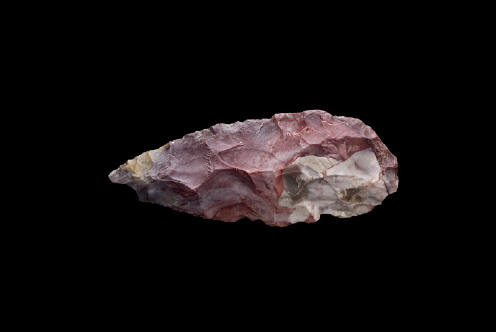 |
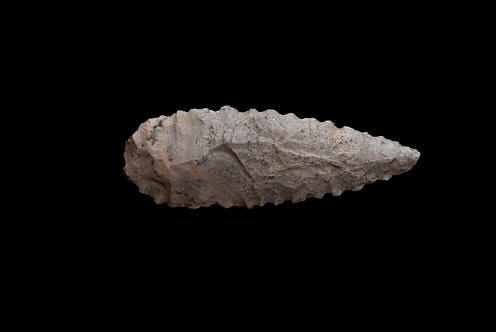 |
Cottonwood Leaf
Desert Traditions Classic/Historic Phases 700 - 200 B.P.
L 2" W 3/4"
Overstreet 10 p. 832 - Arizona and westward into
California and Nevada. A small, thin, leaf shaped arrow point that
resembles a long tear-drop. The base is rounded.
This point was reportedly
found in Arizona
|
|
Cottonwood Triangle
Desert Traditions Classic/Historic
Phases 700 - 200 B.P.
L 1 1/4" W 9/16" Arizona
Overstreet 10 p. 832 - Arizona and westward into
California and Nevada. A small thin triangular arrow point with a
straight to slightly convex basal edge.
This point was reportedly
found in Arizona |
 |
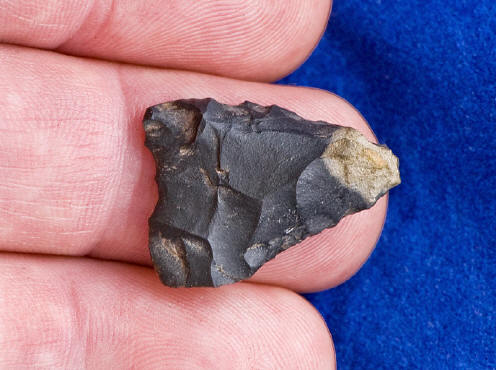 |
Cottonwood Triangle -
Possible exhausted Canaliņo
Desert Traditions Classic/Historic
Phases 700 - 200 B.P.
Arizona and westward into
California and Nevada. A small thin triangular arrow point with a
straight to slightly convex basal edge.
Point Type:
Unifaced
Triangular Arrow Point
L .95"
W .71"
Provenance: Found as a surface find November 2008 on private
land north of Descanso, California by Rob Horne
of Descanso.
Overstreet 10 p. 832 |
|
Dalton
Early Archaic, 10,000 - 9,200 B.P.
L 1.83" W .95"
Tan-Brown Chert
Found in Morgan County, Missouri
Artifact of the Early Archaic Period, Dalton
Complex, dating in the 9500 B.P. range. The Dalton Complex consists of a
group of similar Early Archaic points, each having it's own distribution
range, and several of these ranges overlap with one-another. The Dalton
point and it's varieties are found from the East Coast to the Rocky
Mountains and from the Gulf of Mexico to Canada. The Dalton Cluster includes
the Breckenridge, Colbert, Hardaway, Hardaway side-notched, Greenbrier,
Nansemond, Sloan, Meserve, Tallahassee, Vian Creek, Hemphill, Kisatchie and
the classic Dalton point.
A medium size lanceolate point or knife with
convex blade edges, rounded shoulders and expanded, "eared" base. Lateral
and basal edges are heavily ground and basal thinning is present.
Cross-section is lenticular and flaking is by pressure. Re-sharpenings have
reduced the original size of the blade. Partial fluting on this example.

COA - Western Typology
Benjamin E. Stermer
|


Other Side |
|
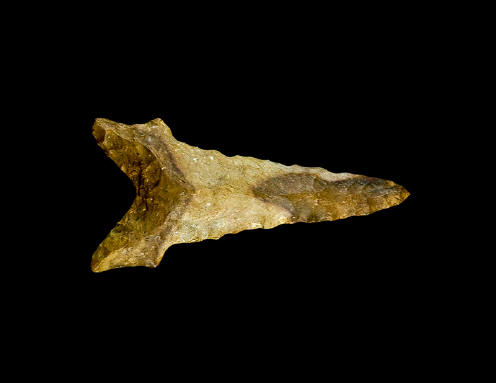 |
Dalton
Early Archaic, 10,000 - 9,200 B.P.
L 2.26" W 1.07
Clay County Arkansas, Bailey's Chert
Overstreet 10 p. 715
- Midwestern to Southeastern states. A medium to large size, thin,
auriculate, fishtailed point. Many are finely serrated and exhibit excellent
flaking. Beveling may occur on one side of each face but is usually on the
right side. All have basal grinding. This type spread over most of the
eastern and Midwestern U.S. and strongly influenced many types to follow.

Another Example |
|
Dalton - Greenbrier
Early Archaic, 9500 B.P.
L 86 mm. W 31 mm.
Dover Chert
Found in Stewart Co., Tenn.
A large dart/knife form that has had two or
three re-sharpenings that have reduced the size of the blade considerably.

Greg Perino COA.
Collectors grade.
ex-John Sisk col.
Midwestern to eastern states and Florida. A
medium to large size, auriculate form with a concave base and drooping to
expanding auricles. Many examples are serrated, some are fluted on
both sides and all have basal grinding. Re-sharpened examples are usually
beveled on the right side of each face although left side beveling does
occur. Thinness and high quality flaking is evident on many examples. This
early type spread over most the U.S. and strongly influenced many other
types to follow.
Overstreet 10 p. 379 |

|
Darl Blade
Woodland, 2500 - 1000 B.P.
L 2.02" W .9"
Texas to Oklahoma. A medium to large size,
thin, lanceolate blade with typical Darl flaking, fine edgework and a
concave to straight base. - Overstreet 10 p. 564
|
 |
 |
Datil
Early Archaic, 7000 - 6000 B.P.
Overstreet 10 p. 835 - The Southern portion of the
southwestern states. A small/dark knife with serrated blade. The stem is
short and rectangular to rounded. Shoulder are straight to obtuse and very
small to non existent in relation to overall size of the point.
L 1 7/16" W 3/4"
This point was reportedly
found in Arizona
|
|
Desert Side Notch, Sierra Side Notch ?
Unknown Origins
L 1.14" x W .6" |
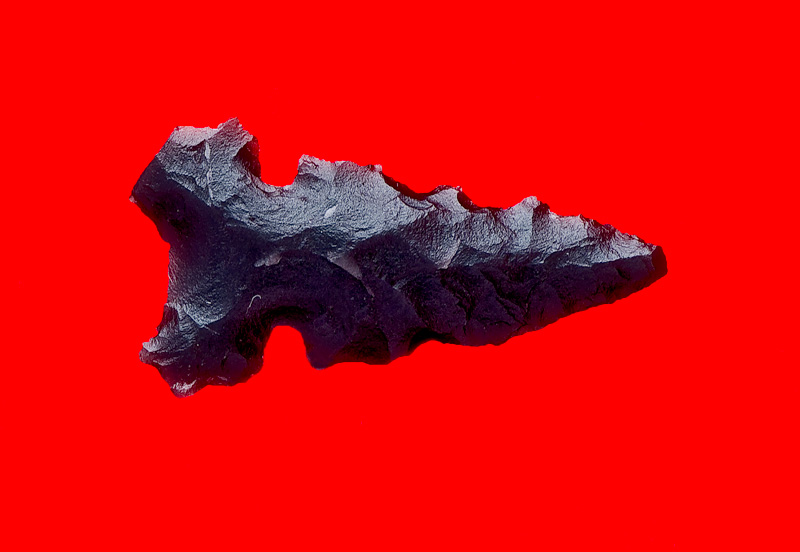 |
 |
Desert Sierra
Side Notched
Classic to Historic, 700 - 200 B.P.
L .91" W
.48
Desert Sierra point from
an old collection found in the 1950's.
Chert - A Great Basin point. No earlier than 1100 to 1200 A.D. to historic
and modern age.
Great Basin Westward. A small size, thin
triangular side and basal notched arrow point with distinctive basal pointed
barbs and basal notch. -
Overstreet 10 p. 1011 |
|
Dickson
Woodland, 2500 - 1600 B.P.
Missouri, made of Burlington Chert
L 2.04" W 1.9"
Grade 7.5
Ex-Bob Herren collection

Baker COA
Midwestern states. Associated with the
Hopewell culture. A medium to large size point with tapered shoulders and a
contracting stem. High quality flaking and thinness is evident on most
examples. -
Overstreet 10 p. 722

Another Example |
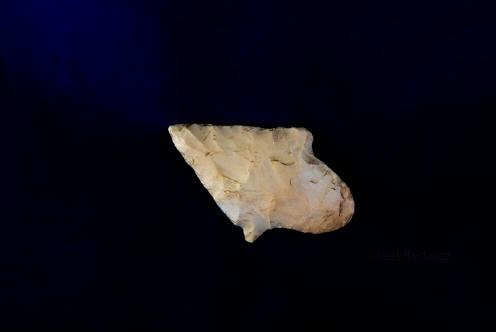 |
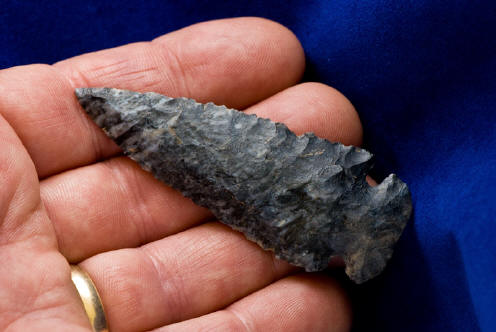 |
Dovetail
Collector's Grade w/Dual COA's
Early Archaic period in the 8,500 B.P.
range A blue and cream
Coshocton Dovetail found by Michael Renihan, spring 2005 in Hendricks Co.,
Indiana. This is a high-quality Dovetail made from a colorful, high-grade
Coshocton flint. It is 2 7/8" in length and 1 1/16" wide. Nice secondary
edge work and a very smooth feeling artifact.

 2005 Jackson Galleries COA &
2006 Davis Artifacts G-9 COA.
Midwestern to Eastern states. A medium to
large size, broad, thin, elliptical, corner notched point with dovetail
base. First stage forms are not beveled. Beveling on opposite sides of each
face occurs during the re-sharpening process. The base is convex and most
examples exhibit quality flaking. -
Overstreet 10 p.474
 |
|
Dovetail
Origin: Clinton County, Ohio
Material: Hornstone
Length: 1 7/8"
Width: 1 7/16"
Early Archaic period in the 8,500 B.P.
range
 Jackson COA
Early Archaic, 9500 - 8000 B.P.
Midwestern to Eastern states. A medium to
large size, broad, thin, elliptical, corner notched point with dovetail
base. First stage forms are not beveled. Beveling on opposite sides of each
face occurs during the re-sharpening process. The base is convex and most
examples exhibit quality flaking. -
Overstreet 10 p.474 |
 |
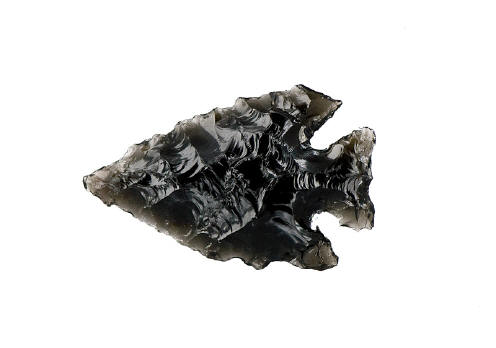
 |
Elko
Late Archaic to Development Phase, 3500 - 1200 B.P.
Blackrock Desert NV.
Finder - Ray Mudge in the 60's
1-5/16" x 7/8"
From late Archaic period around 1500-1300 B.C.
into the intermediate period A.D. 600-700.
The Black Rock Desert is a dry lake bed and
the surrounding endorheic basin in northwestern Nevada in the United States.
The flat expanse of dry lake, or playa, is a remnant of the prehistoric Lake
Lahontan, which existed between 18,000 and 7,000 BC during the last ice age.
During the lake's peak around 12,700 years ago, the desert floor was under
approximately 500 ft (150 m) of water. Black Rock is the site of the annual
Burning Man festival. It is the largest event that occurs there.
Overstreet 10 p. 1018 |

| |
|
Useful
Resources
|
|
|

Authentic
Artifact
Collectors
Association
______
Overstreetid.com
The Official Overstreet Indian
Arrowhead Identification Online Database
______
|
|
|
|
|
|
|